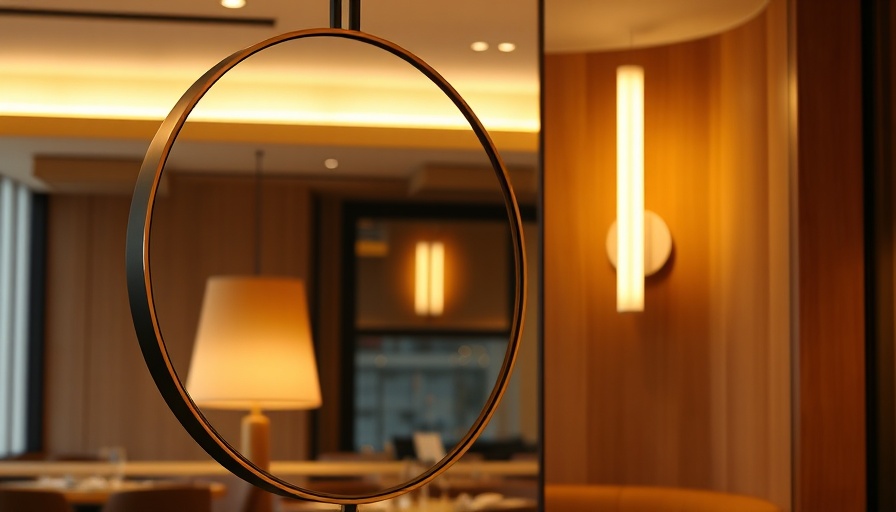
A Warm Embrace: The Cozy Atmosphere of MUSE Restaurant
In a world often dominated by stark designs and industrial aesthetics, MUSE, a new French restaurant in Los Angeles, shines with its warm and inviting interior, carefully curated by Marc Ange Design Studio. This eatery has just reopened its doors, emerging unharmed from the devastating fires that affected its surroundings, including the Pacific Palisades area. For digital nomads and remote workers, MUSE offers not just a dining experience but the kind of atmosphere conducive to sophisticated conversation and creative thought, making it an ideal respite during work breaks.
Curved Designs and Earthy Tones: Comfort Meets Aesthetics
Elegantly draped in earthy caramel tones, the restaurant's design showcases ribbed velvet walls and curved wooden features that together create a cocoon-like environment. The color palette—warm beiges, soft bricks, and gleaming golds—enhances comfort while promoting a relaxed vibe that could inspire even the most hardened remote worker. As you settle into one of MUSE's intimate dining nooks, bathed in the gentle glow of cove and pendant lights, it’s hard not to feel a sense of calm envelop you. This immersive experience echoes the very essence of creating an ergonomic workspace; both places should feel inviting, inspiring, and nurturing for the soul.
A Gallery of Culinary and Artistic Mastery
Art lovers will find MUSE a sensory delight, housing rotating works from renowned Catalan-Spanish painter Joan Miró. As you savor your meal, the vibrant yet soothing art pieces create a dynamic backdrop that inspires creativity and diverse conversations. The marriage of gourmet cuisine and artistic vibrancy resonates with digital nomads who often seek both sustenance and inspiration. According to Marc Ange, the restaurant serves as an oasis for "those yearning for authenticity," and this philosophy extends beyond food, inviting every visitor to partake in a moment of beauty.
French Surrealism Meets California Chic
MUSE is more than a restaurant; it's an embodiment of French surrealism and Italian romance fused harmoniously into California's laid-back coastal lifestyle. The restaurant's ambiance reflects Marc Ange's unique upbringing in Rome and Paris—showcasing how global influences can create locally treasured spaces. For remote workers aiming to integrate work and relaxation, MUSE encapsulates a stress-free environment just a stone's throw from the demanding pace of the city. By striking a balance between luxurious design and home-like comfort, this venue inspires digital nomads to take a moment away from their screens and engage with the world around them.
The Importance of Community-Centric Spaces
In the aftermath of recent calamities, including the fires that scarred the region, MUSE stands as a testament to community revival and resilience. It represents the spirit of gathering—a necessary aspect for mental well-being amongst the remote working culture. Having a space where one can sit in comfort, enjoy nourishing food, and connect with others feels increasingly more important in our hyper-digital age. By prioritizing communal dining experiences, MUSE not only nourishes the body but also feeds our need for *social connection*, which can sometimes falter in the solitary settings typical of remote work.
A Culinary Journey Awaits: The Importance of Intention
Bringing this experience full circle, dining at MUSE is about more than just food; it's an intentional practice designed to evoke pleasure and deep connection. Whether you're looking to escape for an evening of refined dining or simply seeking some comfort while you work remotely, MUSE provides a precious opportunity to engage all senses. As Marc Ange beautifully sums it up, this restaurant is “an intimate experience, suspended in time”—and every visit invites you to reconnect not only with art and cuisine but also with yourself.
So, if you find yourself in Los Angeles and want an inspiring place to work, socialize, or unwind, consider stepping into MUSE—a haven for those who seek beauty and comfort in both design and culinary creations. Don’t miss out on making this beautiful space part of your journey!
 Add Row
Add Row  Add
Add 




Write A Comment